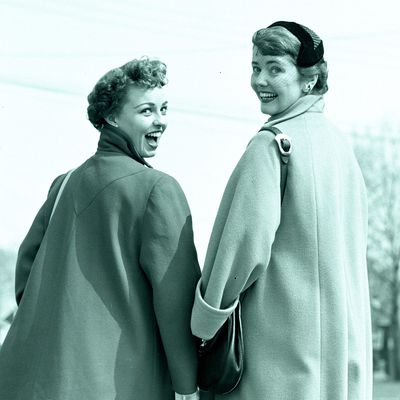
Ask any random collection of strangers what they look for in a friend, and odds are you’ll get pretty similar answers across the board: someone who’s fun to be around. Someone who shares your sense of humor. Someone you can trust.
But often, friendship begins long before any of those things can come to light in any meaningful way. According to one survey, around 60 percent of men and half of women believe in love at first sight; at least that many, I’d wager, have experienced that moment when you meet someone new and feel the friendship blooming in your gut — you just understand, instinctively, that a bond is about to form.
Call it a spark, call it chemistry, call it friendship at first sight; whatever it is, it can happen in just a small handful of seconds, which is the amount of time we need to form a first impression of someone (if that — one study suggests that we make our judgments just a tenth of a second after seeing a face). In a study published in Nature in 2009, researchers identified two areas of the brain that become especially active when we meet someone new: the amygdala, the area of the brain that deals with emotion, and the posterior cingulate cortex, which is linked to autobiographical memory. As Karla Starr noted in Psychology Today, the posterior cingulate cortex also helps us weigh decisions and assign value to objects; we go through a very similar process with humans. “And after we’ve assigned a value to a person, we make the decision about how to orient ourselves to that person,” she wrote. “Do we want to get closer? Knowing what this person’s value is to us, do we want this person to be involved in our network?”
The answer is actually a compilation of several smaller judgments, explains Kelly Campbell, a psychology professor at California State University, San Bernardino. “What are the things we care about in a friend? We care about someone who’s going to be fun, that we can enjoy ourselves with … You need emotional support, social support, you want then to be loyal and trustworthy, you don’t want to feel judged,” she says. “When you first see the person, you don’t realize how many judgments you’re making, but you’re actually gathering information that’s telling you if this person fills those needs for you.”
Last year, Campbell headed up a study in The Social Science Journal on “friendship chemistry,” which she and her colleagues defined as “an instant connection between friends that is easy and makes the relationship seem natural.” (Friendship chemistry, Campbell noted, is one subset of “interpersonal chemistry,” which includes romantic relationships.) The phenomenon wasn’t always mutual, they found, but it seemed to strike certain groups more than others: Those who scored higher on the personality traits of agreeableness, openness, and conscientiousness, for example, were more likely to say that they’d experienced friendship chemistry.
The same was true of female participants, which Campbell believes is a result of gender differences in how we’re socialized to relate to our emotions: From childhood, girls are more often taught to trust them, and boys to tune them out. And friendship chemistry is, at its core, an emotional reaction: “There are two ways we make decisions. There’s cognitive reasoning, where we’re thinking through things, gathering information, being rational, weighing the pros and cons. And there’s the emotional side, which includes things like intuition,” Campbell says. Personal chemistry relies more heavily on the latter: “You’re tapping into the fact that it feels good to be around this person.”
And because first impressions are hard to shake, once we feel that feeling, we tend to stick with it — which means that friendship at first sight may be less of a realization of an objective truth than we think.
“People generally think that they’re pretty good at forming first impressions and that their gut feeling is right somehow,” says Michael Sunnafrank, a communications professor at the University of Minnesota, Duluth, who studies relationships. But “I don’t think they’re accurate in predicting, ‘This is going to be a good relationship for me.’ They make it a good relationship.”
In a 2004 study in the Journal of Social and Personal Relationships, Sunnafrank and his colleague Artemio Ramirez paired up college freshmen for getting-to-know-you conversations; the partners’ initial impressions of one another, the researchers found, were strong indicators of whether they were friendly a few months later. “First encounters, impressions formed during those encounters, and the relational decisions therein have a strong and lasting influence on relationships,” they wrote.
The key word there: decisions. That instinctual sizing-up, in other words, leads to something much more conscious: “What’s really happening here is a self-fulfilling prophecy,” Sunnafrank says. “If you expect [the relationship] not to develop, you’re going to make it not develop. If you expect that it’s going to be positive, you’re more likely to act positively and make it turn in that direction.”
“People form relationships based on their expectation of rewarding futures, and void relationships they think will be less rewarding,” he says. It’s kind of a cold, clinical way to assess something as warm ‘n’ fuzzy as friendship, but it’s true: Your emotional energy is a finite resource, and you’re more likely to invest it in someone who will give you something in return. And if you’re very lucky, that works both ways.




